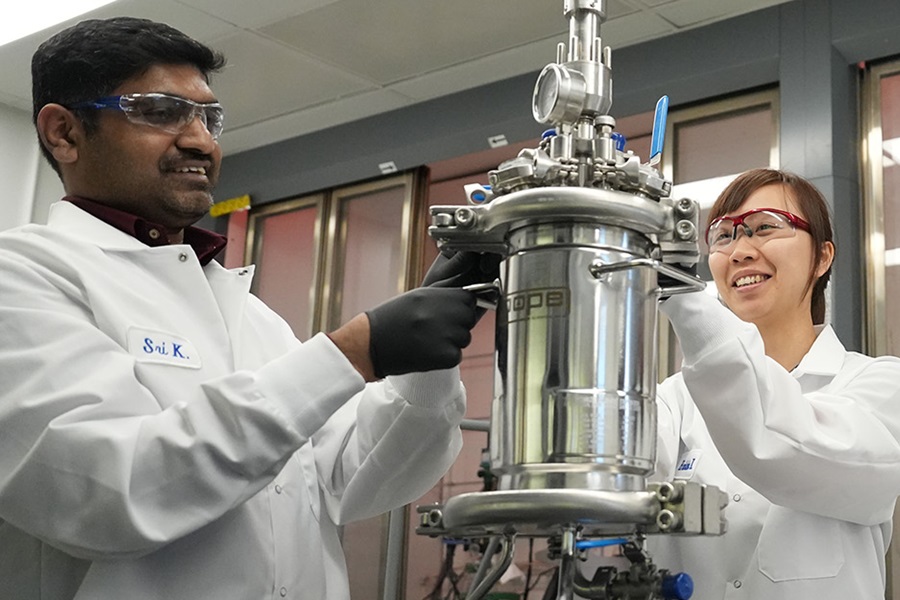Why Abzena?
Trust our focused approach.
A Look into the Pivotal Role of Linker Chemistry in Revolutionizing Antibody-Drug Conjugates
Antibody-drug conjugates (ADCs) represent a groundbreaking class of biopharmaceutical drugs designed to combine the specificity of antibodies with the cell-killing power of cytotoxic drugs. These sophisticated therapies target and destroy cancer cells while sparing healthy ones, a major advancement over traditional chemotherapies. At the core of an ADC’s functionality is the linker, a specialized chemical that attaches the cytotoxic payload to the antibody. This linker is more than a simple glue; it is a critical component that determines the stability, efficacy, and safety of the ADC.
The development of ADCs faces several challenges, particularly in the realm of linker chemistry. The ideal linker must be stable in the bloodstream to prevent premature release of the toxin yet be able to release its payload once inside the targeted cancer cell. Today’s ADCs benefit from decades of research and development, leading to enhanced performance and safety profiles. Here, we look at some of the essential insights for linker development, as shared by our experts at Abzena, to provide a deeper understanding of linker chemistry in ADCs, exploring the evolution, challenges, and innovative solutions that define this field.
Evolution of linker chemistry: since the introduction of the first ADCs, linker chemistry has evolved dramatically. Early ADCs faced challenges with unstable linkers and heterogenous drug-to-antibody ratios (DAR), leading to issues like non-specific payload release and off-target toxicity. Today’s linkers have been refined for better stability and targeted delivery.
Cleavable vs. non-cleavable linkers: linkers fall into two main categories: cleavable and non-cleavable. Cleavable linkers release the payload under certain conditions within the target cell, such as low pH or specific enzyme activity. Non-cleavable linkers, meanwhile, release the drug only upon the ADC’s catabolic degradation.
Importance of conjugation chemistry: the chemistry used to attach the linker to the antibody is crucial. The trend is moving towards site-specific conjugation, which offers better defined and easily characterized ADCs, as opposed to stochastic conjugation methods. In this context, Abzena’s ThioBridge® conjugation technology emerges as a next-generation solution, exemplifying the shift towards site-specific conjugation. It targets antibody interchain disulfides to achieve a uniform DAR and stable attachment. ThioBridge™ not only enhances the stability of the ADC but also provides flexibility in the architectural design of the linker and types of payload, enabling the optimization of pharmacokinetic and potency profiles.
Advances in linker technology: innovations such as site-specific conjugation and cleavable linkers have led to ADCs with improved stability and homogeneity. The latest generation of ADCs incorporates elements like hydrophobicity-masking and solubility-enhancing components for more effective delivery. At Abzena we offer various solutions to achieve optimal linker payload architecture. This process includes stability, activity and safety assessments to support candidate ranking and lead selection to help de-risk the scaling and manufacturing of linker payloads.
Challenges in payload release and stability: efforts are ongoing to ensure that cleavable linkers release the payload only in the target tumor tissue and at an appropriate rate. The stability of the linker in physiological conditions is also a significant consideration.
Developability assessments: a rigorous pre-clinical developability assessment is crucial for selecting the optimal linker. This assessment encompasses all ADC components, evaluating everything from antibody conjugation chemistry to payload release mechanisms. Abzena leverages its extensive experience, having worked with hundreds of candidates, to inform and streamline this process. Our parallel multiparametric evaluation approach covers specificity, functionality, safety, and manufacturability, significantly reducing project timescales.
Cross-functional collaboration: the development of effective ADCs necessitates collaboration across various scientific disciplines. Chemists and biologists must work in tandem to address the complexities of ADC linker chemistry.
Sustainability considerations: beyond scientific and technical aspects, ethical and environmental concerns are also crucial. Sustainable manufacturing processes and the accessibility of ADC technologies are important considerations for the future development of ADCs.
No universal solution: no “one size fits all” and each ADC requires a unique approach to linker design. The choice of linker depends on the specific attributes of the antibody and payload, as well as the intended action of the drug.
Future directions: the field is moving towards the integration of digital tools like computational biology and machine learning to predict linker behavior, potentially revolutionizing the process of ADC optimization. Advanced analytical techniques like mass spectrometry, next-generation sequencing, and chemical modeling play a vital role in understanding and improving ADC linkers to offer comprehensive insights into ADC characteristics.
ADCs stand as a testament to where the optimization of linker chemistry is not just a detail, but a cornerstone of their therapeutic success. As research and technology forge ahead, the evolution of linker chemistry continues to push the boundaries of what is possible in cancer treatment. The future of ADCs promises not only more targeted and effective therapies but also a new horizon in the fight against cancer, where treatments are not only powerful but also precise and patient-centric.
At Abzena our comprehensive approach to linker payload design and synthesis, combined with our knowledge of high potency materials and analytical method development, accelerates the selection of lead drug candidates. We believe that the journey to develop a successful ADC is complex and multifaceted, where tailored solutions are not just beneficial but essential. Our services help to accelerate and de-risk the development and manufacture of next-generation therapies with an integrated approach that supports the entire lifecycle of ADC discovery and development including the design and synthesis of payload-linker constructs for ADCs and conjugates.
Find out more and get in touch with our expert team to explore how our extensive experience and innovative approaches can support and enhance your ADC development projects.
